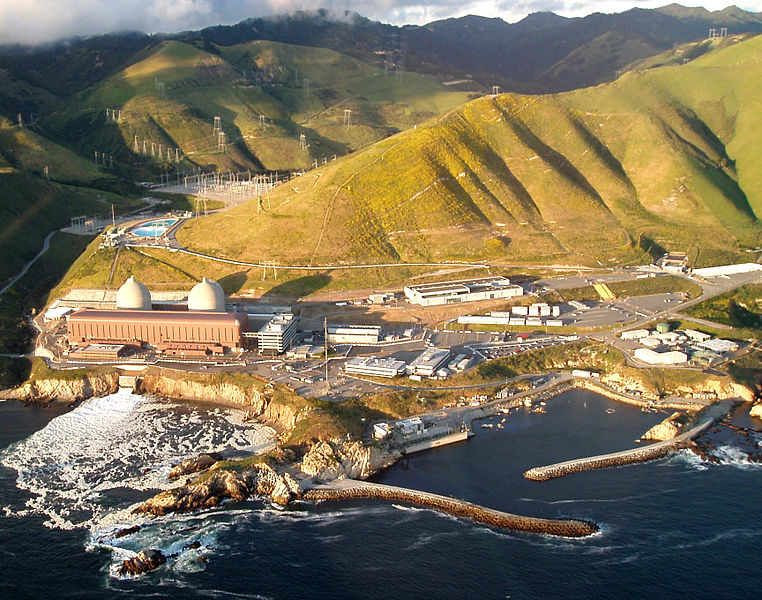Past and Future Collide over Diablo Canyon Nuclear Power Plant
A History of Accidents and Centuries of Radioactive Waste to Come Dog Diablo Operator PG&E

The past and the future collided at a virtual Public Participation Hearing held by the California Public Utilities Commission (CPUC) on July 25. The subject: the potential extension of operations at Diablo Canyon nuclear power plant.
Over 100 commenters spoke. The majority of them (by a 61 percent to 39 percent margin) vigorously opposed continued operations at the plant. As Justin LeBlanc of Sustainable Transit El Dorado put it, “The way of the future is not legacy monoliths.”
Diablo Canyon’s two reactors were scheduled to shut in 2024 and 2025 when their operating licenses expire. A surprise, and very energetic, push by Governor Newsom has led to a last-minute governmental scramble to consider continued operations to 2030 or beyond. The State Legislature has already given a conditional go-ahead.
The CPUC is expected to take a position on the matter before the end of this year. That decision could facilitate or block the extension. Of the five appointed members, a single CPUC commissioner, Karen Douglas, attended the hearing.
Proponents and opponents of the extension definitely did not see the future in the same way. They didn’t agree on the past, either.
Supporters of the extension most frequently cited what they said were ongoing low costs and safe, carbon-free nuclear operations. The mayor of Arroyo Grande, Caren Ray Russom, noted jobs and said that her city is “a direct beneficiary” of the plant’s operations. Jeff Luse, of Generation Atomic, a group that describes itself as “the heart of the pro-nuclear movement,” stated that the radioactive waste stored on site is “safely handled.” Several proponents even advocated adding more nuclear reactors to the site and operating them indefinitely.
Administrative Judge Patrick Doherty, who presided at the hearing, twice had to remind participants to refrain from personal attacks on other speakers. This came after two proponents of the extension referred to those with different views as “eco-terrorists,” “superstitious,” and “propaganda peddlers.”
Those opposed to the extension didn’t need to name-call to make their points. The long list of operational problems of PG&E, Diablo’s operator, did not instill confidence. Elizabeth Brooking of San Francisco, who voiced concerns about how the radioactive waste will be handled for the centuries it will exist, commented that PG&E “doesn’t have an exemplary track record for maintenance.” That’s putting it mildly, as others noted. Adding some dark historical context were Scott Rainsford and Bob Rowen, who described their firsthand experiences with PG&E’s Humboldt Bay nuclear reactor #3, which, they said, experienced a nuclear accident in 1970 that contaminated employees and was covered up by PG&E and the regulatory agencies.
As for continuing Diablo operations beyond the ’24 and ’25 shutdown date, the reasons against that were many and varied. Here are a few that were brought up:
• Under-reported earthquake dangers that downplay the seismic risk to the plant.
• The alarming embrittlement of the metalurgical material inside the reactor vessel of Diablo’s Unit 1: Bruce Severance of San Luis Obispo gave a summary of his findings from reviewing 4,000 pages of U.S. Nuclear Regulatory Commission documents.
• The actual unreliability of the plant’s scheduled operations: Donna Gilmore of SanOnofreSafety.org stated that the two reactors at Diablo had been down 40 percent of the time in the past two years.
• The increasing availability of battery storage as an alternative baseline supply of energy that already exceeds what Diablo offers and will likely exceed it by 3x in the coming two years.
• The uranium mining and transporting that endangers communities near it and contributes significantly to the carbon footprint of nuclear power.
• The financial costs of getting Diablo sufficiently ready to operate any longer than the already agreed upon shutdown: A study by the Environmental Working Group was cited, which states the costs could be as high as $45 billion.
• The absurdity of spending so much to prop up Diablo instead of deploying those funds as rapidly as possible for solar, wind and other renewables: Rooftop solar, in particular, was urged by a number of commenters.
• The danger to the ocean and marine creatures from the once-through cooling system that would apparently be allowed to continue, even though it is no longer an approved process.
• And finally, the unthinkable loss that a catastrophic failure at Diablo would cause.
This last item seems to be something that the proponents of extension want to whistle past, while the opponents of extension do what they can to sincerely sound the loudest possible alarm.
Adrianne Davis of Santa Barbara summed up the Diablo problem succinctly, calling the aging plant a “truly lethal dinosaur.”
And Myla Reson of Santa Monica concluded her remarks with this: “Take a moment to think how you’ll feel if there is a meltdown and you didn’t do anything to shut it.”
There is still time to submit written comments online to the CPUC at apps.cpuc.ca.gov/c/R2301007.
Lauren Hanson and Mary Jones live in Santa Barbara.



